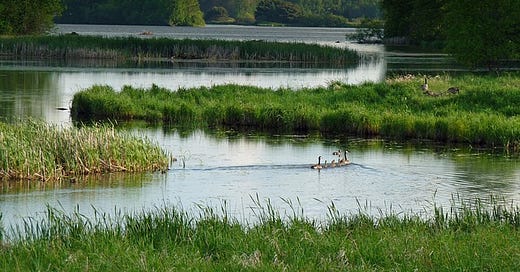Wetland round-up
- Keep up-to-date with the latest wetland and water related news, research and jobs. If you’d like to receive regular updates on all things wetland, please subscribe to this newsletter.
🧾 Wetland news
Beavers create habitat suitable for water voles in Scottish rainforest
More evidence here of the advantages of reintroducing beavers to the right location. The beavers’ dam-building in the forest has led to the creation of a new habitat along the banks of watercourses, where water voles can dig burrows hidden from predatory mink. There’s a great comment in this article by John Taylor, from the Forestry and Land Scotland (FLS): “Water voles and beavers are complementary species and, in their own way, the voles are as busy eco-engineers as their bigger cousins. Their nibbling of sedges and grasses provides space for a greater diversity of wildflowers, while their burrowing shifts soil nutrients to the surface, increasing their accessibility for plant growth.”
Better accounting of peat and mangrove carbon to help Indonesia’s climate policies
Researchers looking into how Indonesia calculates its greenhouse gas emissions from peatlands and mangroves say they’ve identified ways for a more accurate accounting that will help the country meet its emissions reduction goals and refine its climate policies. Hopefully this means even more effort will go into managing the region’s wetlands.
Wetlands scheme to remove pollution gets award
Herefordshire Council has won a national award for its treatment wetland system to remove pollution from the River Lugg around Luston, near Leominster in the UK. Great to see the growing recognition of wetlands as nature-based solutions across different sectors.
Helicopter drops rocks to boost Lake District wetlands
The National Trust is attempting to expand areas of peatlands at Blea Tarn in Langdale, near Ambleside in the Lake District, UK. Tonnes of rocks and timber have been dropped by helicopter to block ditches in the area to hopefully extend the wetland area.
Well worth a read of this article, written by two lawyers discussing how businesses can support the vital need to manage and enhance wetlands in America.
🧪 Wetland research
Scientists discover possible cause of Arctic peatland ‘zombie fires’
Zombie fires in Arctic peatlands disappear from the surface, smoulder underground during the winter, and ‘come back to life’ in the spring. They can release hundreds of megatonnes of carbon into the atmosphere per year. These fires occur in peatlands in Siberia, Canada and Alaska. Researchers originally thought the fires started on the surface and continued smouldering underground. However, it’s now been hypothesised that when microbes break down peat, the process generates heat which can cause spontaneous combustion if the air temperature is warm enough. Crucially it is now thought that it is not so much the absolute air temperature that matters as how fast it rises. Rapid warming causes the process to accelerate until a tipping point is reached where it produces flames. This may explain why zombie fires, rare a century ago, have become more common as the climate changes.
💰 Wetland jobs
Get in-touch 📢
If you’d like to get in-touch please follow Dr Christian Dunn on Twitter/X (@christiandunn) or Instagram (@drchristiandunn), or email c.dunn@bangor.ac.uk.
If you have an image, news item, research item, or job you’d like to share in this newsletter, please get in-touch.




